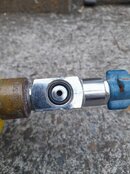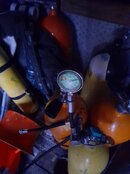In my personal experience I have witnessed two cases of the O-ring excruding on A-Clamps, and one case of the A clamp being dislodged when the cylinder hit the roof inside a wreck, all of these in water incidents. Funnily enough, on all occasions when in the Red Sea.
The big advantage of DIN is that the O-ring is trapped within the valve. Which makes it almost impossible to extrude the O-ring and the valve particularly resistance to lateral force dislodging it.
I have seen one DIN first stage shear off, the cylinder was dropped off the deck onto the quay from about 6 feet, and hit a rail on the way down. Very lucky the accident wasn't more serious. If the rail had been in a slightly different position, there was potential for shearing the cylinder valve off the cylinder or the handle off the valve.
The A-clamp was originally designed with much lower operating pressures in mind.
The DIN valve was designed for operating at higher operating pressures, 300bar. For the lower 232bar, only five complete threads are required, at the higher 300bar, all seven threads need to be engaged.
Equipment that is only suited for 232bar operation has the thread section reduced to only 5 threads to ensure its not fitted to 300bar cylinders.
By any engineering criteria, the DIN design is better.
Hardly a significant criticism the original A-clamp design is quite old (the 50's I think). At that time, twin hose regulators where the norm and the cylinder pressures where considerably lower.
Demand valves have evolved from the original twin hose single valve design to the two valve design we (generally) use now, with the first stage and second stage. With the advent of the two stage valve, cylinder pressures could increase. With the DIN design, cylinder pressures have further increased to a maximum of 300bar. Although, generally (at least in Europe), the low pressure 232 bar is the general norm.





